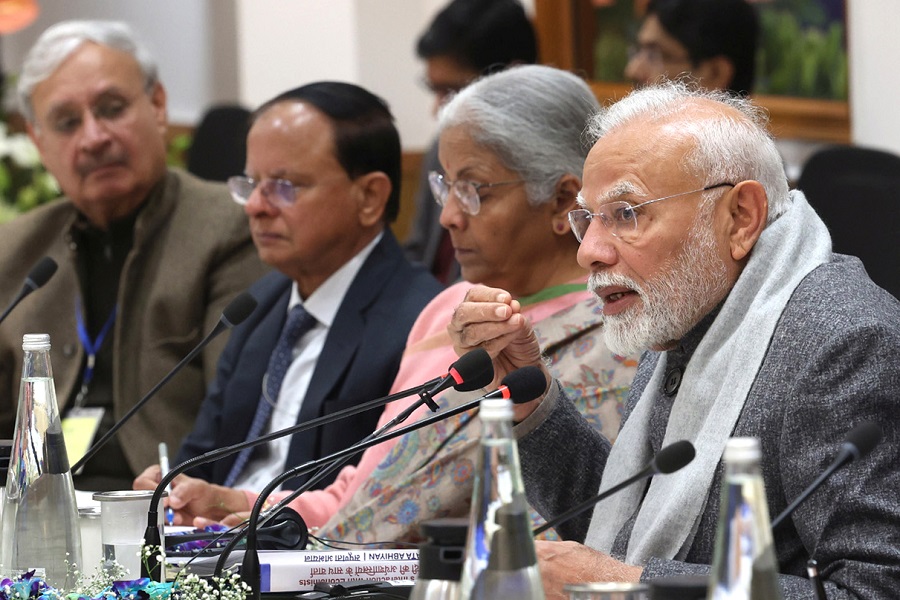Agri Commodity Technical Report 15 March 2023 - Geojit Financial Services

Follow us Now on Telegram ! Get daily 10 - 12 important updates on Business, Finance and Investment. Join our Telegram Channel
SPICES
Mixed moves continued in NCDEX spices complex on Tuesday. Jeera futures stretched gains on firm demand, while coriander futures stayed under pressure from rising arrivals in the spot market and turmeric futures ended on flat note awaiting fresh cues for further directional moves.
• India's export of spices during Apr-Nov declined 14% on year to 898,007 tn, according to data from the Spices Board India. In terms of value, the exports rose marginally by 0.3% to 204.8 bln rupees. Sluggish demand for most spices, including chilli, cardamom, jeera, coriander and ginger, weighed on exports. However, garlic exports rose sharply by 107% on year at 35,175.6 tn. While exports of jeera during Apr-Nov declined 17% on year to 133,250 tn, turmeric exports rose 10% on year to 111,968.5 tn. India exported 28,105 tn of coriander, which is down 15% on year, the data showed. Exports of small cardamom declined 16% on year to 5,355.4 tn. A huge decline of 59% was also seen in ginger exports at 38,765.5 tn. Exports of chilli in Apr-Nov were down 24% on year at 299,611.3 tn, while mint product exports rose 26% on year to 55,434 tn, according to the data.
• Spices Board said it had rescheduled the 14th edition of World Spice Congress from February to Sep 15-17. The congress is scheduled to be held at the CIDCO Exhibition and Convention Centre in Navi Mumbai. The rescheduling is due to constraints in international travel owing to the COVID-19 situation in some of the major spice importing countries. "The venue for the event will remain the same and all existing registrations of delegates and exhibition stalls will be carried forward to the rescheduled event," the board said.
• The value of India's spices market is expected to rise to 1 trln rupees by 2025 from 800 bln rupees this year, with the share of the organised sector likely to reach 50% from 38%, according to experts at the National Spice Conference. Currently, the value of the organised segment is pegged at 300 bln rupees. Improved quality, introduction of smaller stock-keeping units and increased shelf life of spices is one of the major reasons for growth of the organised segment, Ramkumar Menon, chairman of World Spice Organisation, said at the conference. Growth prospects in the case of spices are high and branding plays an important role, as it not only makes a memorable impression on consumers, but allows customers and clients to know what to expect from a company. It is a way to distinguish oneself from competitors and clarify what makes one a better choice, according to a panel of experts at the conference. Currently, the branded spices market is growing at a compounded annual rate of 10-15%, against 7-10% in the case of the unorganised segment. India, the world's largest producer, exporter, and consumer of spices, produces 75 of its 109 varieties. Around 85% of the spices produced in India are consumed domestically. The country accounts for more than 48% of global demand.

COTTON
• The US Department of Agriculture has scaled up its estimate for global cotton output in 2022-23 (Aug-Jul) to 115.0 mln bales (1 US bale = 218 kg) from 114.4 mln bales projected a month ago. Cotton production is expected to be higher as likely larger crops from China, Australia and Uzbekistan will balance out reduced prospects for India, the department said in its World Agricultural Supply and Demand Estimates report for March. Cotton production in India in 2022-23 is seen falling to 24.5 mln tn from 25.5 mln bales estimated in February. However, the output in Brazil is estimated to remain the same at 13.3 mln bales and in the US at 14.7 mln bales. The agency sees global cotton consumption at 110.1 mln bales, down from 110.7 mln bales projected in February due to a decline in use by mills in Turkey, Pakistan, Indonesia, and Bangladesh, the report said. Global ending stocks of cotton in 2022-23 are pegged at 91.1 mln bales, up from 89.1 mln bales projected last month. Consumption in India is estimated to be unchanged at 22.5 mln bales. The estimate for exports from India has been cut to 2.2 mln bales from 2.5 mln bales last month. For Pakistan, consumption is seen at 8.6 mln bales as against 8.8 mln bales projected in February. Cotton ending stocks in India for 2022-23 are now seen at 10.1 mln bales, lower than 10.8 mln bales projected a month ago, the report said.
• The government approved the quality control order for mandatory certification of cotton bales to augment supply of good-quality cotton to the textile industry. The branding of Indian cotton will add great value to the entire cotton value chain, from farmers to end users, Minister of Commerce and Industry Piyush Goyal said today in an interactive meeting with the textile advisory group. Goyal also emphasised on strengthening the testing facility, DNA testing, and traceability. He assured that adequate modern testing facilities would be created through the Bureau of Indian Standards and textile research associations."BIS will ensure setting up of DNA testing facility for textile industry by convergence with Ministry of Textiles," Goyal said. The government also approved a holistic plan to enhance cotton productivity through public-private partnership using cluster based and value chain approach. Steering committee and apex committee have been constituted and the work of traceability and certification will begin in the current cotton season, the government said in a release.
• The Cotton Association of India has retained its production estimate for the 2022-23 (Oct-Sep) season at 34.4 mln bales (1 bale = 170 kg), it said in a press release. Production of cotton in north zone, which includes Punjab, Haryana and Rajastan, is estimated at 4.7 mln bales by the association. The estimate for the central zone, which includes Gujarat, Maharashtra and Madhya Pradesh, is 19.8 mln bales. The estimate for the south zone is 9.2 mln bales. Other small states account for rest of the output. Total supply of cotton for the 2022-23 season is estimated at 38.8 mln bales. The association estimates imports at 1.2 mln bales, 200,000 bales lower from the previous year. Exports are seen at 3.0 mln bales, lower by 1.3 mln bales from the previous year. Arrivals of cotton as on Oct 31 were estimated at 1.8 mln bales by the association. The association sees closing stock of cotton as on Sep 30, 2023 at 5.8 mln bales.

OTHERS
• According to 2nd Advance Estimates released by farm ministry, pulses output is seen at 27.8 mln tn in the ongoing crop year, as against 27.3 mln tn in the previous year. Chana output for 2022-23 is pegged at 13.6 mln tn compared with 13.5 mln tn in 2021-22. Tur output is seen at 3.7 mln tn compared to 4.2 mln tn in the final estimate of last year.
• Rabi chana sowing ends. The area under rabi chana across the country was at 11.2 mln ha as of Thursday, down 2% on year, data from the farm ministry showed. The decline was primarily due to lower sowing in Andhra Pradesh, Chhattisgarh, Jharkhand, Gujarat, and Madhya Pradesh. Sowing of chana across the country has ended for the rabi season. On a week-on-week basis, the total acreage rose 0.6% from 11 mln ha, data showed. In Maharashtra, the second-largest grower, chana was sown across 2.9 mln ha, up 9.6% on year. In Rajashthan, it was sown across 2.1 mln ha, up 4.9% on year. The acreage in Madhya Pradesh, the top grower, declined 11.1% to 2.2 mln ha. In Gujarat, it fell 31% to 765,000 ha, whereas it declined by 18.2% to 341,000 ha in Andhra Pradesh.
• The farm agency of Canada sees chana prices in 2022-23 (Aug-Jul) higher at $1,025 per tn from its estimate of $1,000 per tn in November because of lower world supply. Canada is one of the biggest exporters of pulses to India. "Crop quality is average when compared to the previous year. Supply of chana is forecast to fall by 16% as lower carry-in stocks more than offset the higher production," Agriculture and Agri-Food Canada said in its December report. The farm agency has left price estimates for masur, dry peas, and dry beans unchangedfrom last month at $800 per tn, $460 and $1,210, respectively. World chana output is seen rising to 128,000 tn in 2022-23 from 76,000 tn last season because of higher harvested area and yields, according to the report. The agency has also raised its production estimate for masur to 2.3 mln tn from 1.6 mln tn in the previous year due to higher productivity. Production of dry beans is seen lower at 313,000 tn in this crop year against 386,000 tn a year ago, according to the report.
• The Union Cabinet approved 2-9% hike in the minimum support price of six rabi crops for the coming marketing season starting April. The minimum support price of wheat has been increased by 5.5% to 2,125 rupees per 100 kg, while that of chana was raised by 2.0% to 5,335 rupees per 100 kg, the government said. Wheat, the crucial rabi crop, accounts for over 70% of the rabi foodgrain output, and chana is the largest rabi pulse crop. Minimum support prices, or the rates at which the government buys crops from farmers in case prices slip in the market, gives security and direction to growers in terms of realisation from their produce. They also help boost production of a desired crop. The Cabinet also approved increasing minimum support price of mustard by 7.9% to 5,450 rupees per 100 kg, and for masur by 9.1% to 6,000 rupees per 100 kg. The support price for barley was increased by 6.1% to 1,735 rupees per 100 kg. In the fourth advance estimate, the government predicted output of wheat in the 2021-22 (Jul-Jun) crop year at 106.8 mln tn, while oilseed production is pegged at 37.69 mln tn. Pulses output was seen at 27.69 mln tn, against 27.75 mln tn estimated in the third advance estimate.
* India’s Guar split exports increased in the month of December ’2022 by 21% to 5,440 MT as compared to 4,500 MT previous month. While, the Guar split shipments went up by 66% in December ’22 compared to the same period last year. Out of the total exports, around 3,400 MT (62.5%) was bought by China, 1520 MT (28%) bought by the USA, 220 MT (4.04%) by Germany, 120 MT by Netherlands as well as by Switzerland both and 60 MT by Canada. India’s Guar gum exports increased in the month of December ‘2022 by 16% to 23,136 MT compared to 20,018 MT in the previous month. However, the gum shipments went down by 8% in December 2022 as compared to the same period last year. Out of the total exported quantity, around 10,734 MT (46.4%) was bought by the US, 2,412 MT (10.42%) by Russia, 2,365 MT (10.22%) by Germany, 658 MT (2.84%) by China and 561 MT (2.42%) by UK. We expect Guar gum export in Jan ’22 to be around 22,000-25,000 tonnes.

OIL AND OILSEEDS
* The Solvent Extractors' Association has signed a memorandum of understanding with small-scale farmers of sustainable palm oil in the Malaysian state of Sarawak for supply of palm oil produced by them. The pact is aimed at expanding the market for certified palm oil from Malaysia in India, according to a statement by SEA. The memorandum was signed between four parties – SEA, Solidaridad, Dayak Oil Palm Planters Association, and Persatuan Veteran Angkatan Tentera Malaysia Negeri Sarawak. "The signing of the MoU is considered as one significant step that will accelerate the market access of sustainable palm oil especially from the indigenous palm oil smallholders in Sarawak," said the industry body. Through the pact, small holders of palm oil in Sarawak will receive training on good agricultural practices and climate smart agriculture practices to improve their sustainability, productivity, and livelihood.
* The US Department of Agriculture has scaled down its estimate for global production of oilseeds in 2022-23 (May-Apr) to 629.9 mln tn from 636.7 mln last month. The agency projected global soybean output in 2022-23 at 375 mln, 8 mln tn lower than the estimate in February. Global soybean exports are seen higher at 168.4 mln tn compared to 167.5 mln tn last month due to higher-than-expected shipments through February, the agency said in its March report. In 2022-23, Argentina is seen exporting 3.4 mln tn of soybean, against 4.2 mln tn projected a month ago, while exports by Brazil and Paraguay are estimated at 92.7 mln tn and 6.4 mln tn, respectively. Soybean production in Brazil is estimated at 153.0 mln tn, unchanged from February. Meanwhile, production in Argentina is estimated at 33.0 mln tn, down 8 mln tn from last month's projection. The agency has estimated soybean production in the US at 116.4 mln tn, unchanged from its projection last month. Brazil is the world's top producer of soybean, followed by the US and Argentina.The agency has also lowered its estimate for global ending stocks of soybean to 100 mln tn from 102 mln tn in February. The estimate for global soyoil production in 2022-23 has been scaled down to 60.2 mln tn from 61.0 mln tn a month ago. The agency has revised its estimate for global soyoil exports in 2022-23 marginally lower to 11.8 mln tn from 12.1 mln tn the previous month. "Higher domestic use and reduced production are offsetting, leaving soybean oil stocks unchanged this month," the agency said. The department has projected global soymeal output in 2022-23 at 251.4 mln tn, down from 254.4 mln tn in February. The agency estimates global exports of soymeal at 68.1 mln tn, compared with 69.4 mln tn pegged last month. Soymeal, a derivative of soybean, is manufactured by crushing the oilseed and is mainly used in production of poultry feed.
• The Solvent Extractors' Association of India has urged the government to procure mustard seeds as price of the oilseed is likely to fall below the minimum support price due to rise in daily arrivals. Mustard seed prices have fallen to 5,500-5,525 rupees per 100 kg in key markets of Jaipur, Rajasthan, from 6,100-6,125 rupees on Feb 1. The industry boday said the drop in prices is causing financial loss and serious distress to mustard farmers. In a letter to the secretaries of the farm ministry, food ministry, and commerce ministry, the industry body has urged raising the import duty on RBD palmolein by 20%. "This action will have a salutary effect on improving mustard prices and help improve capacity utilisation of our domestic refining industry," it said. The Union Cabinet has approved a hike in the minimum support price of mustard by 400 rupees per 100 kg for the marketing season starting in April. The current minimum support price is 5,450 rupees per 100 kg. , the oilseed was sold at 5,500-5,525 rupees per 100 kg in key markets of Jaipur, Rajasthan. Prices of edible oils, including mustard, are falling due to unrestricted import of refined palm oil, the industry body said in its letter, adding that this needs urgent policy intervention, as it compromises the nation's edible oil security.
* India's oilmeal exports surged 167% on year to 472,438 tn in January, data released by The Solvent Extractors' Association of India today showed. The rise in exports was primarily on account of higher shipment of soymeal and mustard meal. During Jan, the country exported 238,476 tn mustard meal, significantly higher than 16,164 tn in the year-ago period. The exports of soymeal more than doubled to 110,139 tn. The exports of soymeal and mustard meal have been on a rise since April, and have pushed the overall exports during the year up by 70% to a strong 3.3 mln tn. During Apr-Jan, the export of mustard meal rose to a record 1.9 mln tn against 729,757 tn in the year-ago period, and those of soymeal rose 76.9% to 557,524 tn. "The major consumer of Indian soybean meal are southeast Asia, where India has a logistic advantage and also can supply in small lots," the association said in a release. Additionally, as Indian soymeal is not genetically modified, it is preferred by some European countries and the US, it said. During Apr-Jan, South Korea imported 806,630 tn of oilmeals from India compared with 509,173 tn a year ago, while Vietnam imported 752,142 tn from India, against 478,890 tn a year ago, the association said. In Apr-Jan, 998,173 tn oilmeals were exported from Kandla port against 337,496 tn a year ago. About 1,052,982 tn were exported from Mundra port, up 87.4% from last year. Exports from Mumbai port, including Jawaharlal Nehru Port Trust, were at 239,875 tn against 136,484 tn a year ago. Around 343,341 tn oilmeals were shipped from Kolkata port compared with 388,655 tn a year ago, along with 663,523 tn from other ports which is up 27.5%, the association said.
* According to 2nd Advance Estimates released by farm ministry, the government has pegged oilseed output in 2022-23 at 40.0 mln tn against 38.0 mln tn in the previous year. It has revised its view for soybean output in 2022-23 to 14.0 mln tn from 13.0 mln tn earlier. It has pegged mustard production at 12.8 mln tn as against 12.0 mln tn last year. Groundnut output is seen at 10.06 mln tn against 10.13 mln tn in the previous year.
* Production of crude palm oil in Malaysia fell 14.7% on month to 1.38 mln tn in January, data from the Malaysian Palm Oil Board showed. Exports of palm oil in January fell 23% on month to 1.14 mln tn, while those of biodiesel were down 5.1% on month at 14,239 tn, the data showed. Palm oil is also used to make biofuel. Total stocks of palm oil in the country were down 2.9% on month at 1.26 mln tn as of Januaryend.
* The Soybean Processors Association of India has urged the government to raise the import duty on all edible oils. The association has also sought the abolishment of duty-free tariff rate quota for the import of sunflower oil in 2023-24.
* Maharashtra expects its soybean output to rise 19.7% on year to 6.6 mln tn in 2022-23 (Oct-Sep) kharif marketing season due to better yield and higher acreage, a state government official told Informist. The state's total food grain production, however, is seen a tad lower at 16.5 mln tn. Farmers in Maharashtra had sown soybean across 4.9 mln ha in the 2022-23 (Jul-Jun) crop year, up 6.8% from the previous year because of its remunerative prices of the commodity, the official said. Soybean yield in the state is seen increasing to 1.3 tn per ha in the ongoing season compared to 1.2 tn last year. Madhya Pradesh, Maharashtra, Karnataka, Rajasthan and Gujarat are key growers of soybean. Soybean is predominantly a kharif crop, accounting for around 12% of total food grain production in the country. Total production of oilseeds in the state is seen higher at 6.8 mln tn compared to 5.9 mln tn in 2021-22. Kharif cotton output in the state is also seen rising 5.1% on year to 8.2 mln bales (1 bale = 170 kg) in 2022-23 (Jul-Jun) because of adequate rainfall in Jun-Oct, improving productivity of the crop. Though some areas of the state like Marathwada suffered severe blow due to incessant rains during Aug-Sep, the overall productivity of cotton is seen improving to 329 kg per ha as against 300 kg per ha last year. Maharashta had received about 119% rainfall during Jun-Oct, the official said. Higher production is seen despite lower area under cotton. In 2022-23 (Jul-Jun) kharif season, cotton has been sown across 4.2 mln ha against 4.4 mln ha last year. Sugarcane harvest is estimated to be 144.5 mln tn as against 139.2 mln tn a year ago, the data showed. The crop size is expected to increase due to a rise in yield to 97 kg per ha from 93 kg per ha the previous year. In the ongoing crop year, production of pulses is seen increasing to 5 mln tn against 4.9 mln tn last year, while maize output is estimated a tad higher at 3.7 mln tn.
* In the ongoing 2022-23 (Oct-Mar) rabi season, farmers in the country have sown mustard across 9.7 mln ha as of Wednesday, up 7.7% from a year ago, according to data from the farm ministry. On a weekly basis, mustard acreage was up 0.1% from 9.71 mln ha, the data showed. Mustard is one of the main crops grown in India during the rabi season. The normal area under the crop is 6.34 mln ha. The acreage in Rajasthan, the largest producer of the oilseed, has risen 14% on year to 3.8 mln ha. In Madhya Pradesh, the second-largest producer, the acreage was up 20% at 1.4 mln ha. However, the acreage in Gujarat, Uttar Pradesh, and Haryana was down 10.3%, 9.5%, and 3.2% at 305,000 ha, 894,000 ha, and 732,000 ha, respectively. Prices of mustard are likely to fall in the coming week across key wholesale markets due to weak demand for the old crop before fresh arrivals hit the market in February.
To Read Complete Report & Disclaimer Click Hre
For More Geojit Financial Services Ltd Disclaimer https://www.geojit.com/disclaimer
SEBI Registration Number: INH200000345
Views express by all participants are for information & academic purpose only. Kindly read disclaimer before referring below views. Click Here For Disclaimer












 320-x-100_uti_gold.jpg" alt="Advertisement">
320-x-100_uti_gold.jpg" alt="Advertisement">












